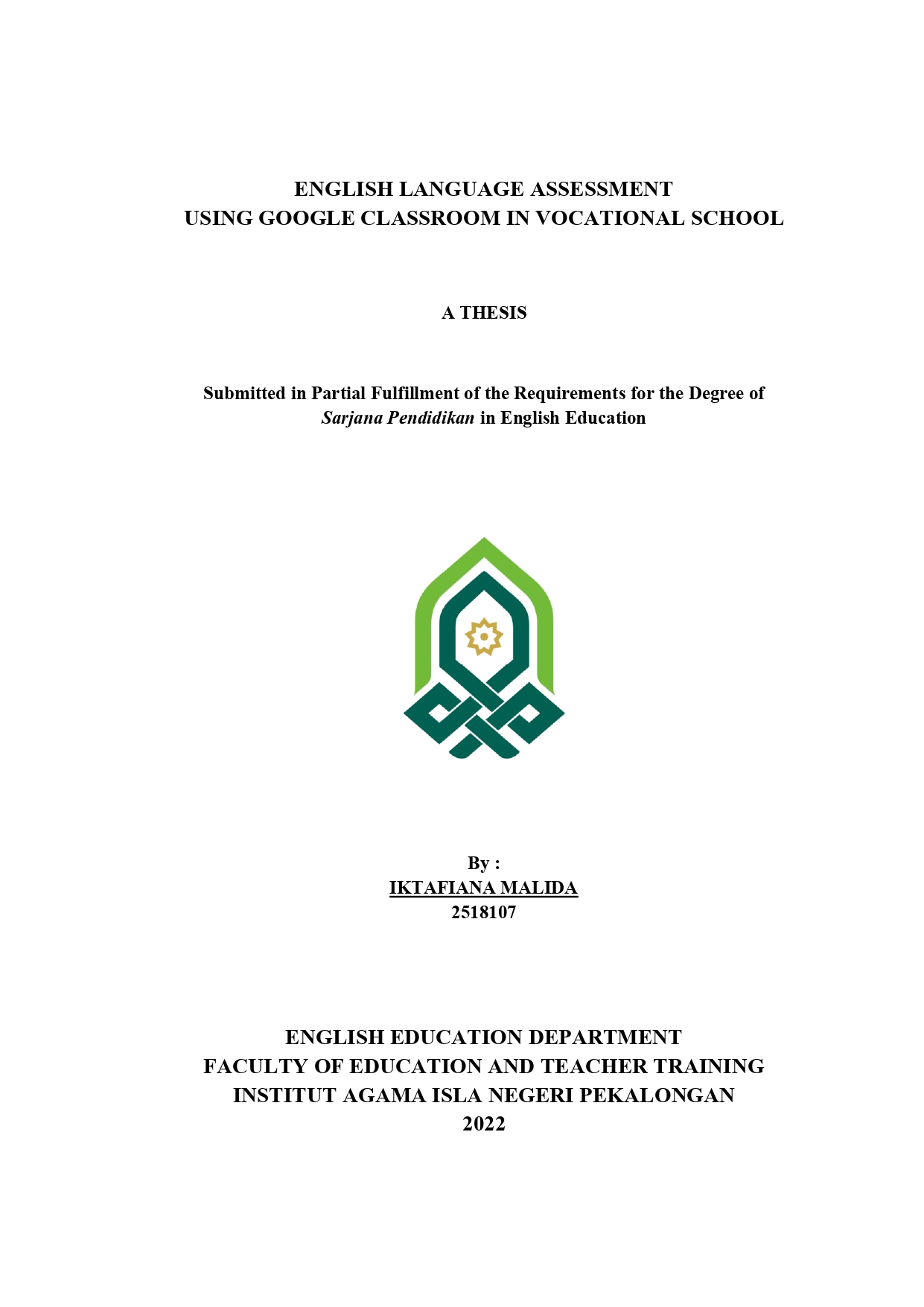
SKRIPSI TADRIS BAHASA INGGRIS
English Language Assessment Using Google Classroom in Vocational School
Google Classroom is an application that makes it easy for teachers and students to do online learning, and one of the features presented in Google Classroom is the assignment feature. This study aims to examine the types of language assessment used during Google Classroom as a learning medium in this technological era. This study also discusses how the implementation of the type of language assessment used by the teacher, the obstacles faced by the teacher when implementing the type of language assessment, and the efforts made by the teacher to overcome these obstacles. The data sources in this study were two English teachers at a Vocational High School in Pekalongan. The type of research used is qualitative. Data collection techniques are carried out by interviews and, observation. The data analysis technique in this study used content analysis techniques. Data were analyzed descriptively by applying the “three basic categories of assessment” by Brown and Hudson. The results of this study indicate that Google Classroom is very supportive of online learning because it can cover four English skills such as listening, speaking, reading, and writing. In addition, teachers also use three types of assessment, namely, selected-response assessment, constructed-response assessment, and personal-response assessment when using the classroom. The low interest of students in learning English is a separate obstacle faced by teachers.
Keywords: Google Classroom, type of language assessment, English Learning, Obstacles, Solutions.
REFERENCES
Almaqfiroh, V. F. (2021). Upaya guru dalam meningkatkan minat belajar siswa kelas IV C pada masa pandemi Covid-19 di MI Darussalam Sugihwaras Candi Sidoarjo (Doctoral dissertation, UIN Sunan Ampel Surabaya).
Arifin, M. N. (2017). Penilaian Otentik dalam Pembelajaran Bahasa Inggris. Saintifika Islamica: Jurnal Kajian Keislaman, 3(01), 111-130
Brown, H. D. (2003). Language assessment: Principles and classroom practices. Pearson Education.
Dewi, N., Zahrowi, E., & Sulistyawati, M. E. (2020). The Implementation of Google Classroom In Improving Students’ Reading Comprehension At MAN 4 Jakarta. Lingual, 9(1), 7.
Febrianti, I., Hariandi, A., & Alirmansyah, A. (2021). Implementasi Penggunaan Google Classroom Pada Pembelajaran Daring Masa Pandemi Covid-19 Di Kelas VI Sekolah Dasar (Doctoral dissertation, Universitas Jambi).
Gultom, E. (2016). Assessment and evaluation in EFL teaching and learning. Proceedings of ISELT FBS Universitas Negeri Padang, 4(1), 190-198.
Hapsari, M. N., & Sufanti, M. (2017). Jenis-Jenis Penilaian Bahasa Indonesia Di Smp Negeri 1 Surakarta Kurikulum 2013 (Doctoral dissertation, Universitas Muhammadiyah Surakarta).
Hapsari, S. A., & Pamungkas, H. (2019). Pemanfaatan Google Classroom sebagai media pembelajaran online di universitas dian nuswantoro. WACANA: Jurnal Ilmiah Ilmu Komunikasi, 18(2), 225-233.
Hasni, H. Penggunaan Media Gambar Untuk Meningkatkan Kemampuan Menulis Kalimat Siswa Kelas II SDN 1 Dongko. Jurnal Kreatif Tadulako, 4(9), 121553.
Iftakhar, S. (2016). Google Classroom: what works and how. Journal of Education and Social Sciences, 3(1), 12-18.
Isda, I. D., Imran, I., Purwati, P., & Rahmiati, R. (2021). The effectiveness of Google Classroom in teaching English during Covid-19 at SMA N 1 M. Payed. Journal of Research on English and Language Learning (J-REaLL), 2(1), 54-60.
Ketersediaan
| 23SK2325048.00 | SK TI 23.048 IKT e | My Library (Lantai 3. Local Content) | Tersedia |
Informasi Detail
- Judul Seri
-
-
- No. Panggil
-
SK TI 23.048 IKT e
- Penerbit
- Pekalongan : Jurusan S-1 Tadris Bahasa Inggris FTIK UIN K.H. Abdurrahman Wahid Pekalongan., 2022
- Deskripsi Fisik
-
xiv, 39 hlm., 30 cm; Bibliografi: 40-43
- Bahasa
-
Inggris
- ISBN/ISSN
-
-
- Klasifikasi
-
371. 35
- Tipe Isi
-
-
- Tipe Media
-
-
- Tipe Pembawa
-
-
- Edisi
-
-
- Subjek
- Info Detail Spesifik
-
-
- Pernyataan Tanggungjawab
-
Iktafiana Malida (2518107)
Versi lain/terkait
Tidak tersedia versi lain
Lampiran Berkas
Komentar
Anda harus login sebelum memberikan komentar
 Karya Umum
Karya Umum  Filsafat
Filsafat  Agama
Agama  Ilmu-ilmu Sosial
Ilmu-ilmu Sosial  Bahasa
Bahasa  Ilmu-ilmu Murni
Ilmu-ilmu Murni  Ilmu-ilmu Terapan
Ilmu-ilmu Terapan  Kesenian, Hiburan, dan Olahraga
Kesenian, Hiburan, dan Olahraga  Kesusastraan
Kesusastraan  Geografi dan Sejarah
Geografi dan Sejarah